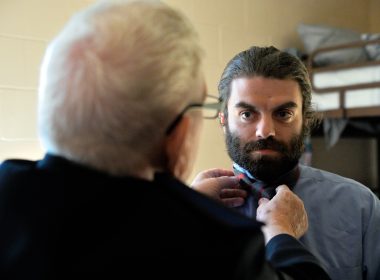A biography of Colonel Bramwell Coles
by Wallace Court –
It was the fall of 1918. World War I was nearing its conclusion, and in a hospital in southern England, a young British Army medical corpsman, suffering from malaria, experienced a feverish hallucination.
“It was as if a door in the heavens opened and some deeply solemn melodies came floating down to me,” he would recall. “It was a vision of Christ, turning toward a pathrough, gloomy and foreboding. The shadow-hung path led to Calvary, dimly discerned in the distance. The face was turned so that one could see those sad eyes, infinite compassion, unfathomed sorrow, most tender pity and exquisite grief. And yet it was a manly face, holding the look of one who has seen what lies at the end of the road, and faces it, calm and unafraid.”
In reality, the hallucination had taken his befuddled mind back to the days of his youth and to the shadowy, gas-lit depiction of Christ: The Man of Sorrows, which hung in his father’s modest home in Nunhead, England.
His parents were Salvation Army officers and the painting, most likely a reproduction, had moved with the family from appointment to appointment, five in all over seven years, and by now was an integral part of the family’s worldly goods.
Where the picture came from remains a mystery and it has long since been lost, the name of the artisan who created it is also unknown. But for all its anonymity, the picture was destined to play a significant role in The Salvation Army’s musical ministry.
What is known is that the young man was Bramwell Coles, a budding composer. In his semi-delirious state he sketched some musical notation and fashioned them into the selection, Man of Sorrows, a classic of Salvation Army music literature.
Both Coles’ music and the painting are based on the words in Isaiah 53:3, “He is despised and rejected of men; a man of sorrows, and acquainted with grief: and we hid as it were, our faces from Him; He was despised and we esteemed him not.”
“Man of Sorrows towers above all Coles’ other compositions for sheer artistry, inspiration and beauty of religious expression,” wrote one critic.
During the next five decades, Bramwell maintained an ongoing manuscript pilgrimage from Gethsemane to Calvary, skillfully melding the melodies of well-known hymns that would bring the events of Good Friday and Easter Sunday to the minds, and souls, of his listeners. In 1947, Bramwell’s life-long journey to the cross resulted in the congregational song, Here at the Cross, which still finds expression in Salvation Army Easter services throughout the world.
How can I better serve thee Lord,
Thou who hast done so much for me?
Faltering and weak my labor has been;
O that my life may tell for thee.
Dull are my ears to hear they voice,
Slow are my hands to work for thee,
Loath are my feet to conquer the steeps.
That lead me to my Calvary.
Strength for my weakness, Lord, impart,
Sight for my blindness, give to me;
Faith for my doubtings, Lord, I would crave.
That I may serve thee worthily.
The chorus laid all his human frailties and soul’s longings at the foot of the cross:
Here at the Cross in this sacred hour,
Here at the source of reviving power,
Helpless indeed, I come with my need;
Lord, for thy service, fit me I plead.
And while time has erased the name of the mystery painter, the name of the musician, his music and his obsession with Christ’s passion lives, rescued, as it were, from temporary delirium to eternal destiny.
Colonel Bramwell Coles’ biography, In the Firing Line, and an accompanying CD of Colonel Coles’ music including Man of Sorrows, is available online from wlcemc@rogers.com.











